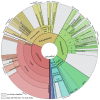Diverse microbiota identified in whole intact nest chambers of the red mason bee Osmia bicornis (Linnaeus 1758)
- PMID: 24205188
- PMCID: PMC3799628
- DOI: 10.1371/journal.pone.0078296
Diverse microbiota identified in whole intact nest chambers of the red mason bee Osmia bicornis (Linnaeus 1758)
Abstract
Microbial activity is known to have profound impact on bee ecology and physiology, both by beneficial and pathogenic effects. Most information about such associations is available for colony-building organisms, and especially the honey bee. There, active manipulations through worker bees result in a restricted diversity of microbes present within the colony environment. Microbial diversity in solitary bee nests remains unstudied, although their larvae face a very different situation compared with social bees by growing up in isolated compartments. Here, we assessed the microbiota present in nests and pre-adults of Osmia bicornis, the red mason bee, by culture-independent pyrosequencing. We found high bacterial diversity not comparable with honey bee colonies. We identified a variety of bacteria potentially with positive or negative interactions for bee larvae. However, most of the other diverse bacteria present in the nests seem to originate from environmental sources through incorporated nest building material and stored pollen. This diversity of microorganisms may cause severe larval mortality and require specific physiological or symbiotic adaptations against microbial threats. They may however also profit from such a diverse environment through gain of mutualistic partners. We conclude that further studies of microbiota interaction in solitary bees will improve the understanding of fitness components and populations dynamics.
Conflict of interest statement
Figures

References
-
- Gilliam M (1997) Identification and roles of non-pathogenic microflora associated with honey bees. FEMS Microbiol Lett 155: 1-10. doi:10.1016/S0378-1097(97)00337-6. - DOI
Publication types
MeSH terms
Substances
LinkOut - more resources
Full Text Sources
Other Literature Sources

